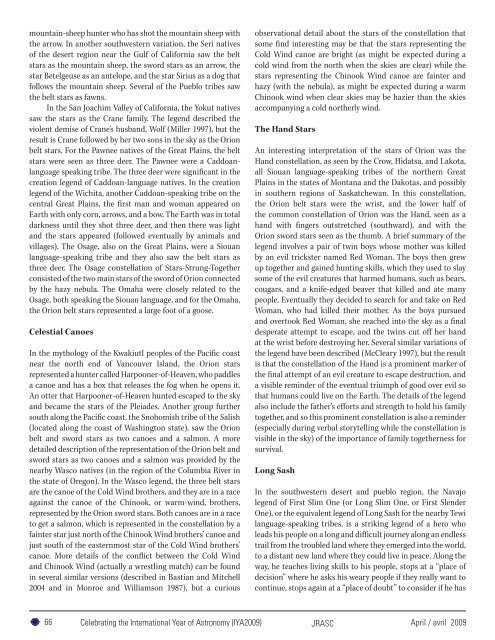Moment
insidethisissue - The Royal Astronomical Society of Canada
insidethisissue - The Royal Astronomical Society of Canada
Create successful ePaper yourself
Turn your PDF publications into a flip-book with our unique Google optimized e-Paper software.
mountain-sheep hunter who has shot the mountain sheep withthe arrow. In another southwestern variation, the Seri nativesof the desert region near the Gulf of California saw the beltstars as the mountain sheep, the sword stars as an arrow, thestar Betelgeuse as an antelope, and the star Sirius as a dog thatfollows the mountain sheep. Several of the Pueblo tribes sawthe belt stars as fawns.In the San Joachim Valley of California, the Yokut nativessaw the stars as the Crane family. The legend described theviolent demise of Crane’s husband, Wolf (Miller 1997), but theresult is Crane followed by her two sons in the sky as the Orionbelt stars. For the Pawnee natives of the Great Plains, the beltstars were seen as three deer. The Pawnee were a Caddoanlanguagespeaking tribe. The three deer were significant in thecreation legend of Caddoan-language natives. In the creationlegend of the Wichita, another Caddoan-speaking tribe on thecentral Great Plains, the first man and woman appeared onEarth with only corn, arrows, and a bow. The Earth was in totaldarkness until they shot three deer, and then there was lightand the stars appeared (followed eventually by animals andvillages). The Osage, also on the Great Plains, were a Siouanlanguage-speaking tribe and they also saw the belt stars asthree deer. The Osage constellation of Stars-Strung-Togetherconsisted of the two main stars of the sword of Orion connectedby the hazy nebula. The Omaha were closely related to theOsage, both speaking the Siouan language, and for the Omaha,the Orion belt stars represented a large foot of a goose.Celestial CanoesIn the mythology of the Kwakiutl peoples of the Pacific coastnear the north end of Vancouver Island, the Orion starsrepresented a hunter called Harpooner-of-Heaven, who paddlesa canoe and has a box that releases the fog when he opens it.An otter that Harpooner-of-Heaven hunted escaped to the skyand became the stars of the Pleiades. Another group furthersouth along the Pacific coast, the Snohomish tribe of the Salish(located along the coast of Washington state), saw the Orionbelt and sword stars as two canoes and a salmon. A moredetailed description of the representation of the Orion belt andsword stars as two canoes and a salmon was provided by thenearby Wasco natives (in the region of the Columbia River inthe state of Oregon). In the Wasco legend, the three belt starsare the canoe of the Cold Wind brothers, and they are in a raceagainst the canoe of the Chinook, or warm-wind, brothers,represented by the Orion sword stars. Both canoes are in a raceto get a salmon, which is represented in the constellation by afainter star just north of the Chinook Wind brothers’ canoe andjust south of the easternmost star of the Cold Wind brothers’canoe. More details of the conflict between the Cold Windand Chinook Wind (actually a wrestling match) can be foundin several similar versions (described in Bastian and Mitchell2004 and in Monroe and Williamson 1987), but a curiousobservational detail about the stars of the constellation thatsome find interesting may be that the stars representing theCold Wind canoe are bright (as might be expected during acold wind from the north when the skies are clear) while thestars representing the Chinook Wind canoe are fainter andhazy (with the nebula), as might be expected during a warmChinook wind when clear skies may be hazier than the skiesaccompanying a cold northerly wind.The Hand StarsAn interesting interpretation of the stars of Orion was theHand constellation, as seen by the Crow, Hidatsa, and Lakota,all Siouan language-speaking tribes of the northern GreatPlains in the states of Montana and the Dakotas, and possiblyin southern regions of Saskatchewan. In this constellation,the Orion belt stars were the wrist, and the lower half ofthe common constellation of Orion was the Hand, seen as ahand with fingers outstretched (southward), and with theOrion sword stars seen as the thumb. A brief summary of thelegend involves a pair of twin boys whose mother was killedby an evil trickster named Red Woman. The boys then grewup together and gained hunting skills, which they used to slaysome of the evil creatures that harmed humans, such as bears,cougars, and a knife-edged beaver that killed and ate manypeople. Eventually they decided to search for and take on RedWoman, who had killed their mother. As the boys pursuedand overtook Red Woman, she reached into the sky as a finaldesperate attempt to escape, and the twins cut off her handat the wrist before destroying her. Several similar variations ofthe legend have been described (McCleary 1997), but the resultis that the constellation of the Hand is a prominent marker ofthe final attempt of an evil creature to escape destruction, anda visible reminder of the eventual triumph of good over evil sothat humans could live on the Earth. The details of the legendalso include the father’s efforts and strength to hold his familytogether, and so this prominent constellation is also a reminder(especially during verbal storytelling while the constellation isvisible in the sky) of the importance of family togetherness forsurvival.Long SashIn the southwestern desert and pueblo region, the Navajolegend of First Slim One (or Long Slim One, or First SlenderOne), or the equivalent legend of Long Sash for the nearby Tewilanguage-speaking tribes, is a striking legend of a hero wholeads his people on a long and difficult journey along an endlesstrail from the troubled land where they emerged into the world,to a distant new land where they could live in peace. Along theway, he teaches living skills to his people, stops at a “place ofdecision” where he asks his weary people if they really want tocontinue, stops again at a “place of doubt” to consider if he has66 Celebrating the International Year of Astronomy (IYA2009)JRASC April / avril 2009
















